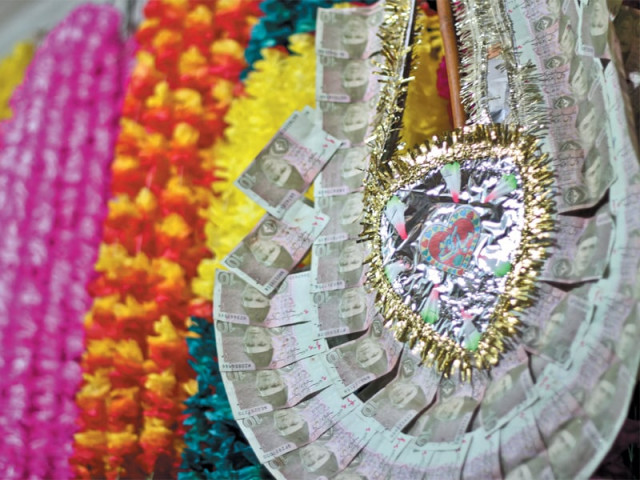Cutting back on luxuries: Wreaths of money
Rising inflation has led to cutting back on luxuries.

Cutting back on luxuries: Wreaths of money
Once seen dotting many a road side, money garlands or ‘notoon walay haar’ seem to be disappearing from Lahore’s ‘posh’ market places like Liberty, Gulberg and Defence. Yet, despite the onslaught of debilitating inflation, these garlands — so unique to our culture — are doing thriving business in mass markets like Ichra.
“Nobody buys flower garlands beyond the posh market places,” says Muhammad Shehzad, who has been in the flower decoration business for over nine years. His shop is located in the prime spot on the main road of the Ichra market. Shehzad claims that on good days, sales easily average about Rs100,000. “For the moneyed classes it seems a bit ‘over’ and showy-offy to wear these garlands,” offers Shehzad by way of explanation as to why these garlands have phased out of the larger posher markets.
As it turns out though, money garlands are quite a lucrative business. Even with recession and inflation, Shehzad maintains that business isn’t affected and he even gets orders to make these garlands with dollars from American expats who visit the country during Christmas holidays or family weddings. “Mostly, these garlands are used for sehra bundi,” he informs.
“Initially, grooms would keep wearing it during the entire ceremony but since it’s so inconvenient and uncomfortable, nowadays, grooms just adorn it for a short while.” Sales for these garlands increase during Rabiul Awal and Zil Haj along with the wedding seasons of the summer and winter where daily sales exceed over Rs 100, 000. Needless to mention, sales slow down during Muharram and Safar.
Meanwhile, Shehzad’s neighbour, Khurram, who is also in the same business and has been maintaining his shop for the last 13 years, admits that sales have decreased over the years, citing inflation as the main reason. “These aren’t new notes,” he points out to the money garlands hanging in his modest store. “These are all second-hand notes. When we had the one and two-rupee notes, back in the day, business was thriving. We fared decently well even with the five-rupee notes but now that they have stopped, business has waned.”
The cost of making a basic garland is about Rs150 and the minimum that these stores require is Rs500 worth of notes to be threaded in. “We sometimes reduce it to Rs200, but for very few clients,” says Shehzad.
Money for the garlands is either delivered by the customers themselves or the garland vendors procure it themselves from the Shah Almi market. “The banks would usually give us notes,” says Shehzad. “But now they demand that you must have a bank account in that specific branch. Hence, it’s easier to just go to money vendors in Shah Almi who sell these notes (of ones, twos, fives etc) and charge an extra Rs120 for a Rs1,000 wad of notes”.
One can’t help but wonder if these stores ever think of using counterfeit money or play money? The vendors are appalled by the suggestion, stating that it is bad business practice to do so since mostly family members order these garlands as a gift for the groom and such a lowly thing would adversely affect family relations.
Published in The Express Tribune, December 26th, 2011.



















COMMENTS
Comments are moderated and generally will be posted if they are on-topic and not abusive.
For more information, please see our Comments FAQ